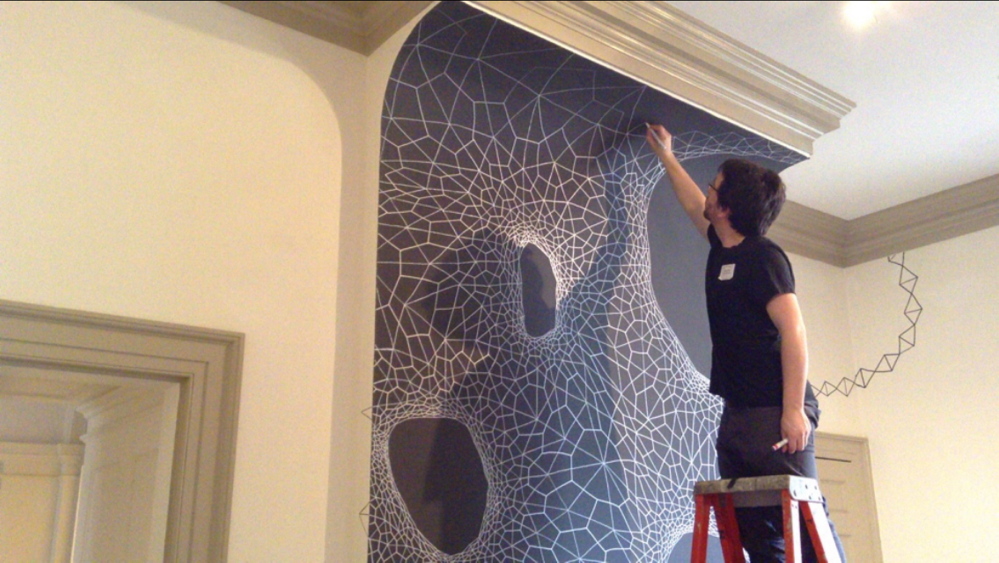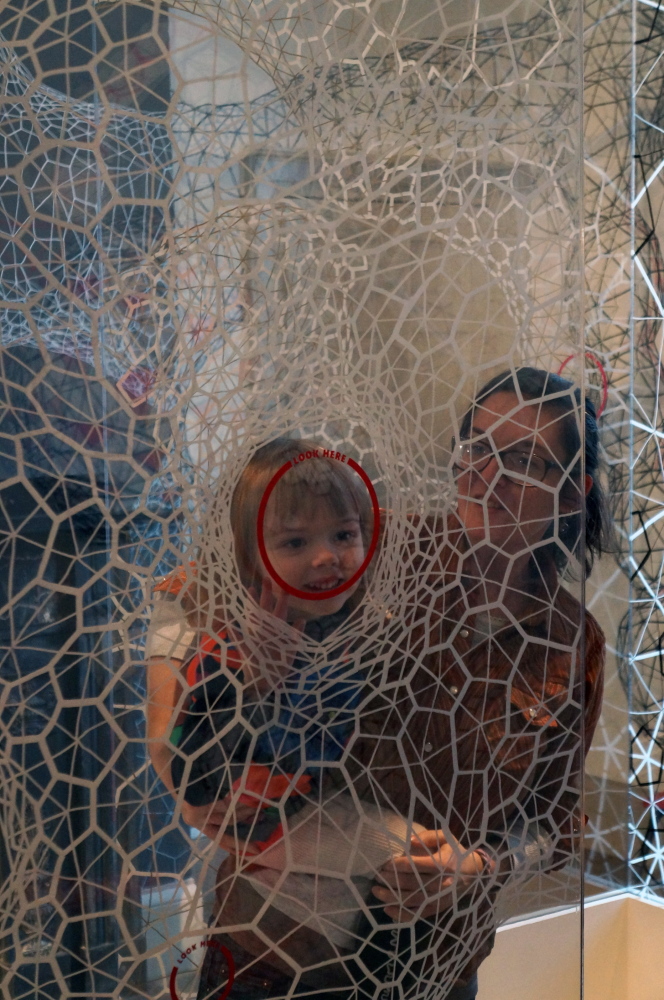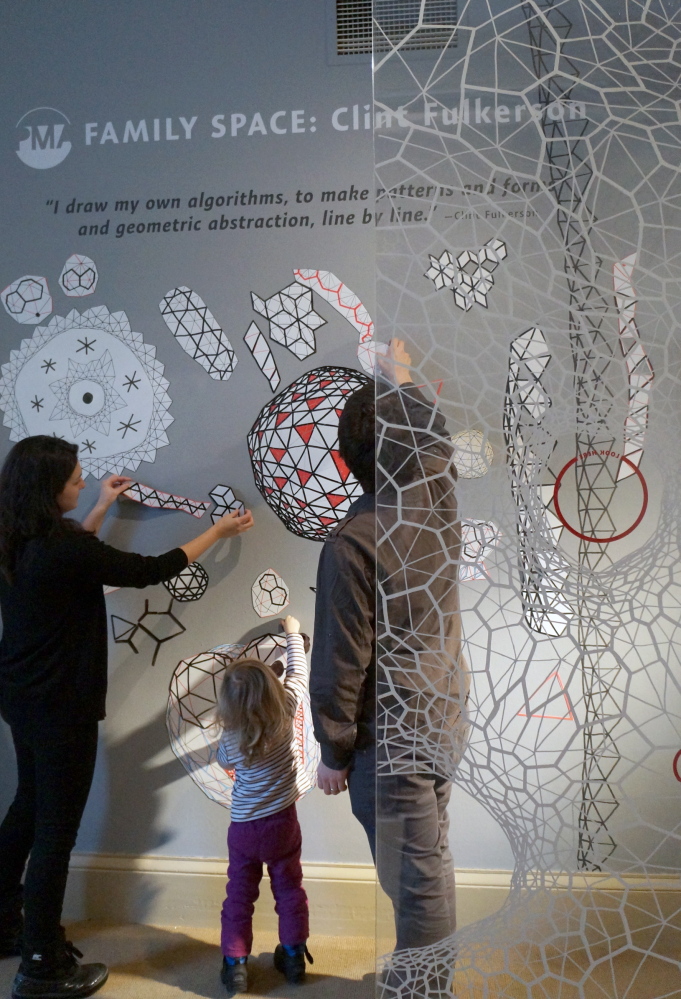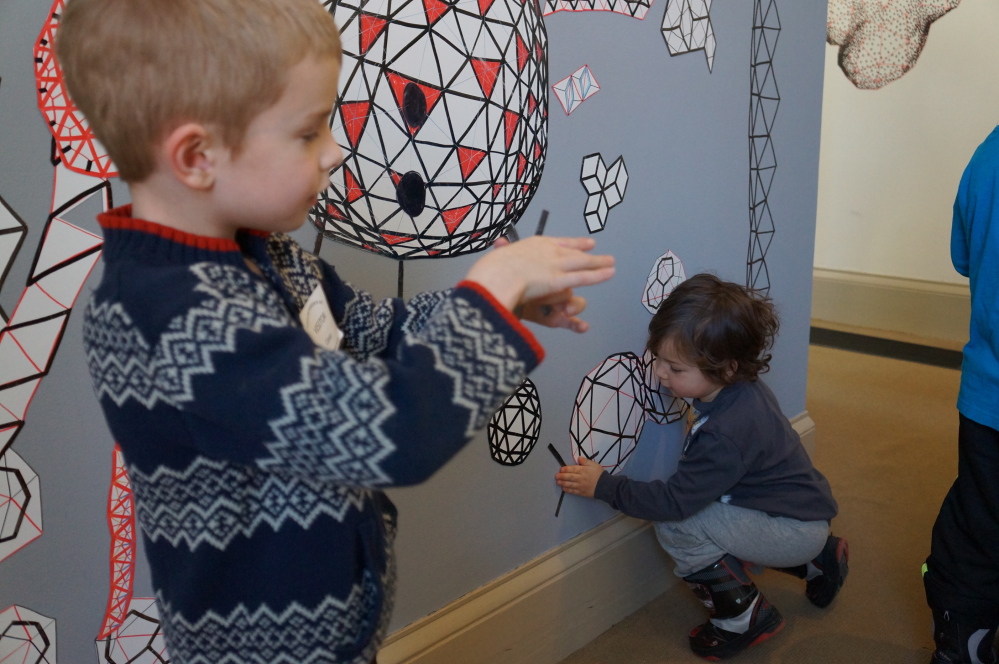Why is there a Family Space at the Portland Museum of Art? Is it just a marketing thing?
Or is the PMA – Maine’s leading public art institution – genuinely dedicated to educating Mainers about art?
The answer is clear to anyone who frequents the museum: The PMA is indeed dedicated to education, learning and the family experience of art.
Clint Fulkerson is the artist whose installation now graces the PMA’s Family Space for Youth Art Month, and the museum still uses his design for the YAM awards that he created years ago while a youth participant.
Winning such an award is the kind of thing that changes lives. We will never know if Fulkerson was destined for a career as an artist before the PMA award, but he is certainly blossoming as a professional artist. His recent work at Ed Pollack Fine Arts, Space Gallery and on public view on Congress Street have all merited mention in this column.
Fulkerson’s Family Space installation comes on the heels of Jason Rogenes’ visually fantastical installation. Rogenes covered the walls and ceiling of the Family Space with geometrically cubist cardboard forms and covered the windows with Styrofoam elements taken from boxes for things like televisions or microwaves. The Styrofoam is translucent, so the placement over the window offered a glow to the already magical installation. It was like walking onto the set of the seminal 1920 German Expressionist film “The Cabinet of Dr. Caligari” (Das Kabinet des Dr. Caligari).
Rogenes then put out what amounted to a giant train table covered with plaster casts of Styrofoam elements that visitors of all ages couldn’t help but use to create towers and structures. My kids loved it – and I enjoyed it even more than they did.
Fulkerson’s environment is very different. Instead of Rogenes’s fantastically all-encompassing theatricality, Fulkerson’s geometrical meanderings are more like doodles growing organically throughout the space. They look complex but they clearly introduce their own logic. So, while Fulkerson’s work is contemporary art that smartly juggles content like systems logic, Boolean algebra, geometrical forms and 3D rendering, it’s easy to understand how Fulkerson makes it. Kids of all ages will get it.
Fulkerson’s drawing – made with various paint markers – seems to riff on hexagonal systems as it flows all over the walls in the Family Space and on a set of Plexiglas sheets that stand in the center of the room. It’s not likely the artist would have chosen so much labeling and commentary, but it certainly gives the viewers something to latch onto – and with families, even a single point of welcome can make all the difference.
Among the bonus material, Fulkerson has designed a geometrical project (a Dimaxion-type cut-out globe) that families can take home as well as a shape-based scavenger hunt that led my boys to shoot off immediately out of my sight in opposite directions in a fine art museum (fun for sure – for them – so be prepared).
While we came out of the Rogenes installation excited and impressed, my boys left Fulkerson’s installation inspired and raring to draw.
With my guys at least, Fulkerson made a bullseye.
Youth Art Month has certainly worked out for Fulkerson – who is also in a just-opened show in New York City – but is it a worthy investment to focus on art education? After all, there are plenty of folks who think art is an unworthy hobby rather than a useful vocation.
But make no mistake about it: Art is one of Maine’s leading economic engines. Portland alone supports the equivalent of more than 1,500 full-time arts and culture jobs, a 2012 Americans for the Arts survey found.
Art class is the first real vocational training our kids get in school, and a public school child in Maine is more likely to be an artist than work in the lumber industry.
So we should think about art education – to make sure we’re doing it well.
Unlike any other industry, across the state there are many institutions outside of the public schools that are professionally engaged in educating visitors about art. It’s worth asking yourself why that is.
One notable problem is the widespread American meme that art is fundamentally self-expression. The easiest way to illustrate the conundrum is to imagine that we taught literature in public schools by handing kids stacks of legal pads and assigning them to write appealing and well-crafted novels relying on nothing but their own personal inspiration.
As a former public school teacher and studio instructor, I believe we would be helping Maine students by increasing the emphasis on art history and art appreciation (I like the term “vis-ed”) rather than focusing solely on studio practice.
While we have a ways to go in schools, the public realm of art in Maine is particularly interesting because art is something families can experience together at the commercial galleries (free!) and community-oriented nonprofits that dot the state, as well as at any of our numerous significant museums.
Freelance writer Daniel Kany is an art historian who lives in Cumberland. He can be contacted at:
dankany@gmail.com
Send questions/comments to the editors.






Success. Please wait for the page to reload. If the page does not reload within 5 seconds, please refresh the page.
Enter your email and password to access comments.
Hi, to comment on stories you must . This profile is in addition to your subscription and website login.
Already have a commenting profile? .
Invalid username/password.
Please check your email to confirm and complete your registration.
Only subscribers are eligible to post comments. Please subscribe or login first for digital access. Here’s why.
Use the form below to reset your password. When you've submitted your account email, we will send an email with a reset code.